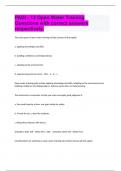Padi 13 open water Study guides, Class notes & Summaries
Looking for the best study guides, study notes and summaries about Padi 13 open water? On this page you'll find 27 study documents about Padi 13 open water.
Page 3 out of 27 results
Sort by
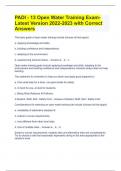
-
PADI - 13 Open Water Training Exam- Latest Version 2022-2023 with Correct Answers
- Exam (elaborations) • 5 pages • 2023
-
Available in package deal
-
- $8.49
- + learn more
The basic goals of open water training include (choose all that apply) a. applying knowledge and skills. b. building confidence and independence. c. adapting to the environment. d. experiencing extreme stress. - Answer-A. , b. , c. Open water training goals include applying knowledge and skills, adapting to the environment and building confidence and independence. Extreme stress does not help learning. The statement to remember to help you teach and apply good judgment is a....
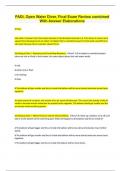
-
PADI, Open Water Diver, Final Exam Review combined With Answer Elaborations
- Exam (elaborations) • 27 pages • 2023
-
- $19.49
- + learn more
PADI, Open Water Diver, Final Exam Review combined With Answer Elaborations D float. Salt water is heavier than fresh water because it has dissolved minerals in it. This means it causes more upward force (buoyancy) on an object. An object that is neutrally buoyant in fresh water would float in salt water because there is greater upward force. See Being a Diver I - Buoyancy and Controlling Buoyancy. Ans 1) If an object is neutrally buoyant (does not sink or float) in fresh water, the same ...
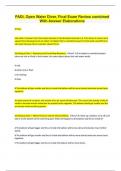
-
PADI, Open Water Diver, Final Exam Review combined With Answer ElaborationsPADI, Open Water Diver, Final Exam Review combined With Answer Elaborations D float. Salt water is heavier than fresh water because it has dissolved minerals in it. This means it c
- Exam (elaborations) • 27 pages • 2023
-
- $17.49
- + learn more
PADI, Open Water Diver, Final Exam Review combined With Answer Elaborations D float. Salt water is heavier than fresh water because it has dissolved minerals in it. This means it causes more upward force (buoyancy) on an object. An object that is neutrally buoyant in fresh water would float in salt water because there is greater upward force. See Being a Diver I - Buoyancy and Controlling Buoyancy. Ans 1) If an object is neutrally buoyant (does not sink or float) in fresh water, the same ...
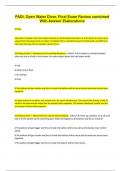
-
PADI, Open Water Diver, Final Exam Review combined With Answer Elaborations
- Exam (elaborations) • 27 pages • 2024
-
- $15.49
- + learn more
PADI, Open Water Diver, Final Exam Review combined With Answer Elaborations D float. Salt water is heavier than fresh water because it has dissolved minerals in it. This means it causes more upward force (buoyancy) on an object. An object that is neutrally buoyant in fresh water would float in salt water because there is greater upward force. See Being a Diver I - Buoyancy and Controlling Buoyancy. Ans 1) If an object is neutrally buoyant (does not sink or float) in fresh water, the same ...
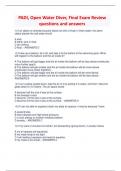
-
PADI, Open Water Diver, Final Exam Review questions and answers
- Exam (elaborations) • 13 pages • 2024
-
- $13.99
- + learn more
PADI, Open Water Diver, Final Exam Review questions and answers 1) If an object is neutrally buoyant (does not sink or float) in fresh water, the same object placed into salt water would A sink. B either sink or float. C do nothing. D float. - ANSWERS D 2) I blow up a balloon, tie it off, and take it to the bottom of the swimming pool. What will happen to the balloon and the air inside it? A The balloon will get bigger and the air inside the balloon will be less dense (molecules mo...
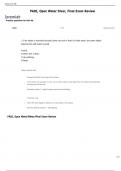
-
PADI, Open Water Diver, Final Exam Review Practice questions for this set Learn 1 / 7 Study with Learn 1) If an object is neutrally buoyant (does not sink or float) in fresh water, the same object placed into salt water would A sink. B either sink
- Exam (elaborations) • 15 pages • 2024
- Available in package deal
-
- $7.29
- + learn more
PADI, Open Water Diver, Final Exam Review Practice questions for this set Learn 1 / 7 Study with Learn 1) If an object is neutrally buoyant (does not sink or float) in fresh water, the same object placed into salt water would A sink. B either sink or float. C do nothing. D float. Choose matching term A become half the size it was at the surface. At 10 meters, the pressure is 2 bar. An air volume taken to this depth from the surface would decrease 1 and be...
PADI - 13 Open Water Training Questions with correct answers respectively.

How much did you already spend on Stuvia? Imagine there are plenty more of you out there paying for study notes, but this time YOU are the seller. Ka-ching! Discover all about earning on Stuvia



